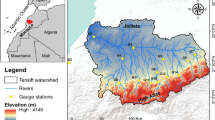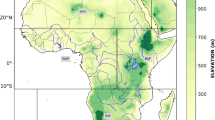Abstract
The relationship between meteorological and hydrological drought is in focus in the catchment of Blanice River (Central Bohemia Region, South Bohemia Region). Drought indices used in and presented are the Standardized Precipitation Index (SPI) and the Streamflow Drought Index (SDI). Drought was first analyzed from both the meteorological and hydrological point of view, and then the indices were compared in order to identify the importance of preceding period length in the occurrence of hydrological drought. The total area of the catchment is 534 km2 and is located 50 km southeast of Prague. For the assessment of drought, data from one hydrological gauging station and from a number of meteorological stations were used. The time series used are more than 50 years long. The analyses of precipitation data carried out were supported by GIS application in order to get areal precipitation data based on available station data. Drought indices were calculated on the basis of data for the entire period; however, the analysis of the relationship between SDI and SPI covers only the period from 1961 to 2015 for which the values were available for both considered indices. The results of performed analyses show the correlation between hydrological and meteorological drought indices which is strongest for the reference periods from 3 to 6 months.







Similar content being viewed by others
References
Al-Faraj FA, Scholz M, Tigkas D (2014) Sensitivity of surface runoff to drought and climate change: application for shared river basins. Water 6(10):3033–3048
Al-Faraj FA, Tigkas D (2016) Impacts of multi-year droughts and upstream human-induced activities on the development of a semi-arid transboundary basin. Water Resour Manag 30(14):5131–5143
Bates BC, Kundzevic ZW, Wu S, Paultikof JP (eds) (2008) Climate change and water. IPCC technical paper IV. IPCC Secretariat, Geneva
Ben-Zvi A (1987) Indices of hydrological drought in Israel. J Hydrol 92(1–2):179–191
Bordi I, Fraedrich K, Jiang M, Sutera A (2004) Spatio-temporal variability of dry and wet periods in eastern China. Theor Appl Climatol 79:81–91
Brázdil R, Trnka M, Dobrovolný P, Chromá K, Hlavinka P, Žalud Z (2009) Variability of droughts in the Czech Republic, 1881-2006. Theor Appl Climatol 97:297–315
Daňhelka J, Boháč M, Crhová L, Čekal R, Černá L, Fiala R, Chuchma F, Kohut M, Kourková H, Kubát J, Kukla P, Kulhavá R, Možný M, Reitschläger JD, Sandev M, Sřivánková P, Šercl P, Štepánek M, Valeriánová A, Vlnas R, Vrabec M, Vráblík M, Zahradníček P, Zrzavecký M (2015) Vyhodnocení sucha na území České republiky v roce 2015 - Předběžná zpráva (The evaluation of drought in the area of Czech Republic in 2015 – Prelimnary report). CHMI, Prague
David V, Davidova T (2015a) Analysis of available retention volume in extinct ponds–case study for Blanice River catchment. Agric Agric Sci Procedia 4:79–87
David V, Davidova T (2015b) Identification and frequency analysis of drought events in the Blanice river catchment (Czech Republic) in: Andreu J, Solera A, Paredes-Arquiola J, Haro-Monteagudo D, van Lanen H (Eds.). Drought: research and science-policy interfacing. CRC press, pp. 177-182
David V, Davidová T (2016) Assessment of summer drought in 2015 using different indices in the catchment of Blanice River. Procedia Engineering 162:45–55
Fiala T, Ouarda TBMJ, Hladny J (2010) Evolution of low flows in the Czech Republic. J Hydrol 393:206–218
Gasiorek E, Musial E (2015) Evaluation of the precision of standardized precipitation index (SPI) based on years 1954-1995 in Lodz. Journal of Ecological Engineering 16(4):49–53
Giddings L, Soto M, Rutherford BM, Maarouf A (2005) Standardized precipitation index zones for México. Atmosfera 18(1):33–56
Gumus V, Algin HM (2016) Meteorological and hydrological drought analysis of the Seyhan− Ceyhan River basins, Turkey. Meteorol Appl 24(1):62–73
Guttman NB (1999) Accepting the standardized precipitation index: a calculation algorithm. J Am Water Resour Assoc 35(2):311–322
Hayes MJ, Svoboda MD, Wilhite DA, Vanyarkho OV (1999) Monitoring the 1996 drought using the standardized precipitation index. Drought mitigation center faculty publications, paper 31
Hisdal H, Stahl K, Tallaksen LM, Demuth S (2001) Have streamflow droughts in Europe become more severe or frequent? Int J Climatol 21(3):317–333
Hong X, Guo S, Zhou Y, Xiong L (2015) Uncertainties in assessing hydrological drought using streamflow drought index for the upper Yangtze River basin. Stoch Env Res Risk A 29(4):1235–1247
Kazemzadeh M, Malekian A (2016) Spatial characteristics and temporal trends of meteorological and hydrological droughts in northwestern Iran. Nat Hazards 80(1):191–210
Karavitis CA, Alexandris S, Tsesmelis DE, Athanasopoulos G (2011) Application of the standardized precipitation index (SPI) in Greece. Water 2:787–805
Lake PS (2003) Ecological effects of perturbation by drought in flowing waters. Freshw Biol 48(7):1161–1172
Lee Rodgers J, Nicewander WA (1988) Thirteen ways to look at the correlation coefficient. Am Stat 42:59–66
Marheb M, Moussa R, Abdallah C, Colin F, Perrin C, Baghdadi N (2016) Hydrological response characteristics of Mediterranean catchments at different time scales: a meta-analysis. Hydrol Sci J 61(14):2520–2539
McKee TB, Doeskin NJ, Kieist J (1993) The relationship of drought frequency and duration to time scales. Proc. 8th Conf. On applied climatology, January 17–22, American Meteorological Society, Boston, Massachusetts, 179–184
Mishra AK, Singh VP (2011) Drought modeling–a review. J Hydrol 403(1):157–175
Nalbantis I, Tsakiris G (2009) Assessment of hydrological drought revisited. Water Resour Manag 23(5):881–897
Nguyen V, Li Q, Nguyen L (2017) Drought forecasting using ANFIS - a case study in drought prone area of Vietnam. Paddy Water Environ 1–12. doi:10.1007/s10333-017-0579-x
Pearson K (1920) Notes on the history of correlation. Biometrika 13:25–45. doi:10.2307/2331722
Potop V, Türkott L, Kožnarová V, Možný M (2010) Drought episodes in the Czech Republic and their potential effects in agriculture. Theor Appl Climatol 99(3–4):373–388
Quitt E (1971) Klimatické oblasti Československa. Academia, Studia Geographica 16, GÚ ČSAV v Brně, 73 s
Smakthin VU (2001) Low flow hydrology: a review. J Hydrol 240:147–186
Tabari H, Nikbakht J, Talaee PH (2013) Hydrological drought assessment in northwestern Iran based on streamflow drought index (SDI). Water Resour Manag 27:137–151
Tigkas D, Vangelis H, Tsakiris G (2012) Drought and climatic change impact on streamflow in small watersheds. Sci Total Environ 440:33–41
Treml P, Zahrádková S, Hájek O (2015) Vymezení oblastí vysychání vodních toků v ČR (Defining areas of drying up streams in the Czech Republic). In: Rožnovský J, Litschmann T, Středa T, Středová H (eds) Extrémy oběhu vody v krajině
Tsakiris G, Nalbantis I, Vangelis H, Verbeiren B, Huysmans M, Tychon B, Jacquemin I, Canters F, Vanderhaegen S, Engelen G, Poelmans L, De Becker P, Batelaan O (2013) A system-based paradigm of drought analysis for operational management. Water Resour Manag 27(15):5281–5297
Van Loon AF, Laaha G (2015) Hydrological drought severity explained by climate and catchment characteristics. J Hydrol 526:3–14
Vicente-Serrano SM, Beguería S, Lorenzo-Lacruz J, Camarero JJ, López-Moreno JI, Azorin-Molina C, Revuelto J, Morán-Tejeda E, Sanchez-Lorenzo A (2012) Performance of drought indices for ecological, agricultural, and hydrological applications. Earth Interact 16(10):1–27
Zahrádková S, Hájek O, Treml P, Pařil P, Straka M, Němějcová D, Polášek M, Ondráček P (2015) Hodnocení rizika vysychání drobných vodních toků v České republice. VTEI 2015:4–16
Acknowledgements
This paper presents the research undertaken within the research project NAZV KUS QJ1620395 “Restoration and building of ponds in forest areas as a part of sustainable water resources management in CZ” funded by Ministry of Agriculture of the Czech Republic. The support is highly acknowledged. A previous version of the paper has been presented in the 2nd EWaS International Conference: “Efficient & Sustainable Water Systems Management toward Worth Living Development”, Chania, Crete, Greece, 1-4 June 2016. Authors are grateful to the reviewers for their useful recommendations and comments.
Author information
Authors and Affiliations
Corresponding author
Rights and permissions
About this article
Cite this article
David, V., Davidová, T. Relating Hydrological and Meteorological Drought Indices in Order to Identify Causes of low Flows in the Catchment of Blanice River. Environ. Process. 4 (Suppl 1), 149–161 (2017). https://doi.org/10.1007/s40710-017-0223-1
Received:
Accepted:
Published:
Issue Date:
DOI: https://doi.org/10.1007/s40710-017-0223-1




